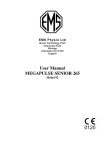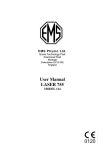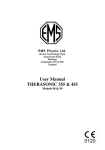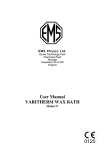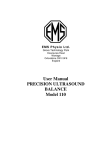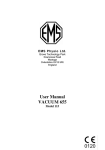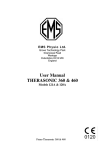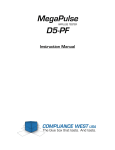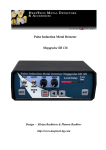Download User Manual MEGAPULSE IIA
Transcript
E M S P h ys i o L td Grove Technology Park Downsview Road Wantage Oxfordshire OX12 9FE England User Manual MEGAPULSE IIA Model 65B Megapulse IIA 2 Issue 4 General Information This manual provides the necessary information for the installation and operation of the Megapulse Senior IIA unit. These instructions must be studied before putting the unit into operation. The information contained in this manual is subject to change without notice. No part of this manual may be photocopied, reproduced or translated into another language without the prior written consent of EMS Physio Ltd. The Megapulse IIA is a pulsed shortwave therapy unit. Shortwave therapy been applied to a wide range of conditions with successful outcomes. These include acute and subacute traumatic and inflammatory conditions, chronic rheumatoid and arthritic conditions, resolution of haematomas and for pain relief. . It is intended that the Megapulse IIA is only used by qualified healthcare professionals such as physiotherapists who have received training in electrotherapy. Record of Amendments ISSUE 1 2 3 4 COMMENTS Initial Issue Revised EMC Tables added Updated for model 65B DATE 18/01/2000 17/02/2005 10/03/2008 02/07/2009 Megapulse IIA Iss4 3 EC Declaration of Conformity EMS Physio Ltd Grove Technology Park Downsview Road Wantage Oxfordshire OX12 9FE United Kingdom Declares that the following medical device is in conformity with the essential requirements and provisions of Council Directive 93/42/EEC and is subject to the procedure set out in Annex 2 of Directive 93/42/EEC under the supervision of Notified Body Number 0120, SGS United Kingdom Ltd. Product Name Megapulse IIA Model Number 65B Signature Position Technical Director Date 2 July 2009 Megapulse IIA 4 Issue 4 Contents page 1 Title General Information 3 Record of Amendments 3 Declaration of Conformity to 93/42/EEC 4 Contents 5 Warranty 6 Introduction 7 Precautions & Contraindications 9 Technical Specification 10 Treatment Chart 12 Installation 14 Controls and Markings 15 Operating Instructions 20 Maintenance 22 EMC Tables 23 Megapulse IIA Iss4 5 Warranty This EMS Physio Ltd., (hereinafter called the company) product is warranted against defects in materials and workmanship for a period of two years from the date of shipment. The Company will at its option, repair or replace components which prove to be defective during the warranty period, provided that the repairs or replacements are carried out by the Company or its approved agents. The Company will consider itself responsible for the effects on safety, reliability and performance of the product:only if assembly operations, re-adjustments, modifications or repairs are carried out by persons authorised by it, only if the product is used in accordance with the instructions for use, only if the electrical installation of the relevant room complies with the appropriate national requirements. Should the product be returned to the Company for repair it must be sent carriage paid. Consumable items, for example, electrodes, electrode covers and batteries, are excluded from the above warranty. Megapulse IIA 6 Issue 4 Introduction Shortwave Therapy Shortwave refers to electromagnetic radiation in the frequency range 2 to 100 MHz. Shortwave therapy is the application of electromagnetic energy to the body at shortwave frequencies. At these frequencies the electromagnetic energy is converted to thermal energy by the induction of circulating currents in the tissue and dielectric absorbtion in insulating tissue. Shortwave therapy units may produce output power levels of up to 500W providing significant heating to the area of the body being treated. For this reason the treatment is often called shortwave diathermy (through heating). To avoid equipment such as shortwave therapy units interfering with radio communications, certain frequency ranges are designated by international agreement as ISM (Industrial, Scientific and Medical) bands. These are shown in the following table:Centre Frequency MHz 6.78 13.560 27.120 40.680 433.92 915 2450 5800 24125 61250 122500 245000 Frequency Range MHz 6.765-6.795 13.553-13-567 26.957-27.283 40.66-40.70 433.05-434.79 902-928 2400-2500 5725-5875 24000-24250 61000-61500 122000-123000 244000-246000 Maximum Radiation Limit Under Consideration Unrestricted Unrestricted Unrestricted Under Consideration Unrestricted Unrestricted Unrestricted Unrestricted Under Consideration Under Consideration Under Consideration Shortwave therapy equipment normally uses the band centred on 27.12 MHz. This corresponds to a wavelength, in a vacuum, of approximately 11 metres. Shortwave therapy is normally applied at a level which produces detectable heating and the benefits are those associated with the heating effect - encouragement of healing, pain relief, reduction of muscle spasm, increase in mobility etc. Megapulse IIA Iss4 7 The difference between shortwave therapy and other methods of heating is that it provides “deep heat”. Other heating techniques such as infrared therapy, hot-packs etc., provide the heat externally whereas shortwave therapy generates heat within the tissue. As with any electrotherapy, there are several potential dangers associated with shortwave therapy. Since relatively high powers are used, there is the possibility of producing burns if the patient is unaware of the heat due to reduced thermal sensation, or if the patient does not know what to expect during treatment. Metal in treatment area will provide low impedance paths to the induced radio frequency current, producing local heating and the possibility of burning. In particular, treatment should never be given in the area of metal implants, metal jewellery, buckles etc must be removed and treatment must never be given with the patient on metal framed couches or chairs. Patients with implanted electronic devices such as cardiac pacemakers must not be treated. Other equipment, including patient connected devices, may be adversely affected when in close proximity to shortwave therapy equipment. Pulsed Shortwave Therapy Conventional shortwave therapy equipment described above, produces a continuous wave output at 27.12 MHz. Pulsed shortwave therapy equipment delivers the energy in pulses or bursts of shortwave energy. The pulses are typically 20 to 400 microseconds in duration (pulse width) and are repeated with a frequency of 5 to 800 Hz (pulse frequency). As with other modalities such as ultrasound, it is found that delivering the energy in pulses is often therapeutically more beneficial that providing the same amount of energy in continuous wave form. Pulsed shortwave therapy appears to be effective for many conditions especially in the early stages of recovery. Because the output is pulsed, the average output power levels can be very low (less than 1W) and still produce effective treatment. The Megapulse IIA Pulsed Shortwave Unit provides a peak power of 150W and average powers from a few mW to 48W. As the power levels are lower than with conventional shortwave therapy equipment, some of the potential dangers associated with the modality no longer apply. At average powers of less than 5 W, treatment may be given over areas containing metal implants, through wound dressings or plasters, and on couches or chairs with metal frames. A list of necessary precautions and contraindications is provided in the following sections. Megapulse IIA 8 Issue 4 Precautions & Contraindications Precautions The function of certain implanted electrical devices, for example pacemakers, may be adversely affected during treatment with pulsed shortwave therapy. In case of doubt, the advice of the physician in charge of the patient should be sought. The function of other patient connected equipment may be adversely affected by the operation of shortwave therapy equipment. Hearing aids should be removed. Treatment should not be given through clothing although it is permissible to treat through a dressing or plaster. External conductive material should be removed from the immediate treatment area, however, areas containing internal metallic implants may be treated at low power levels (less than 5 W average power) without special precautions. Contraindications Tumours, due to the risk of increased growth or metastatic activity. Pregnancy, do not treat the lower abdomen, back or pelvis. Menstruation, do not treat lower back or abdomen due to risk of increased bleeding or pain. Cardiac conditions, do not treat the chest area or near the cervical ganglion. Cardiac pacemakers, especially demand type, or any other implanted electronic device. Patients with reduced thermal sensitivity in the proposed treatment area should not be treated with shortwave therapy. Megapulse IIA Iss4 9 Technical Specification General Power Input Classification (EN60601-1) Mains Fuses Size (height x width x depth) Weight 100 -240 Vac 50/60 Hz, 150VA Class 1, Type BF 2 x T2A (5 x 20 mm) 870 x 410 x 410 mm 37 kg (excluding HI-Q applicator) Shortwave Frequency Maximum Output Power 27.12 MHz (± 120 kHz) 150 W (± 20%) peak power into 50 ohms Modes 1∆T 20 min, 100µs, 800Hz fixed 2∆T 20 min, 200µs, 800Hz fixed 4∆T 20 min, 400µs, 800Hz fixed VAR 0 min, 65µs, 100Hz In VAR mode the treatment time, pulse width and frequency may be set to the values below:Timer Pulse Widths Pulse Frequencies Timer accuracy 0 to 30 minutes in 1min increments 20, 40, 65, 100, 200, 400 µs 50, 100, 200, 400, 600, 800 Hz ± 1 second All information on model, serial number, and month/year of manufacture is located on the rear panel. Each Megapulse IIA is supplied with a HI-Q applicator, treatment chart, field detector and this manual. The Megapulse IIA has been designed to meet the requirements of BS EN 60601-1:2001 "Medical Electrical Equipment, Part 1:General requirements for Safety", BS EN 60601-2-3:1998 "Medical Electrical Equipment, Part 2.3 Particular requirements for the safety of shortwave therapy equipment" Megapulse IIA 10 Issue 4 Output Waveform The pulse width may be set to 20, 40, 65, 100, 200 or 400 µs. The Period may be from 1.25 ms (800Hz) to 20 ms (50Hz) The duty cycle (%) is given by: Pulse Frequency (Hz) x Pulse Width (µs) / 10000 Environmental Conditions for Transport and Storage Temperature -10 to +35 C Relative Humidity 5 to 95% Atmospheric Pressure 500 to 1060 hPa Environmental At the end its life, the Megapulse IIA should not be disposed of as unsorted general waste. Advice on appropriate disposal is available from EMS Physio Ltd. For continued safety, only electrodes and cables supplied by EMS Physio Ltd. should be used with the Megapulse IIA. Megapulse IIA Iss4 11 PULSE WIDTHS (microseconds) Treatment Chart 400 3 6 12 24 36 48 200 1.5 3 6 12 18 24 100 0.75 1.5 3 6 9 12 65 0.5 1 2 4 6 8 40 0.3 0.6 1.2 2.4 3.6 4.8 20 0.15 0.3 0.6 1.2 1.8 2.4 50 100 200 400 600 800 PULSES PER SECOND ACUTE 0.15 – 2.4 W SUBACUTE (resolving) CHRONIC 3–9W above 12 W It is the peak power of the pulsed output which produces the effective treatment. However, for ease of selecting the control setting the output is expressed in average power (watts). The chart illustrates the range of powers available for the various conditions to be treated. Megapulse IIA 12 Issue 4 Spacing The applicator should be placed with its rim 1 cm from the treatment site (thus maintaining a sterile field of treatment). Examples of chronic conditions which respond well;Disorders of the musculo-skeletal system, eg degenerative joint disease, chrinic rheumatoid arthritis and osteo-arthritis. Sprains, strains, muscle and tendon tears, capsule lesions, sinusitis, pelvic conditions. Examples of conditions which respond well in both the acute and sub-acute stages:ligamentous sprains, intramuscular haematoma, haemorrhoids, oedema, post-natal conditions (episiotomy, bruised perineum) acute disc lesions, periarthritis (acute), sciatica, sinusitis, tendinitis, tenosynovitis, pressure sores, leg ulcers, post-operative oedema, bursitis. Pain relief to osteo-arthritis, low back pain, frozen shoulder, ankylosing spodylitis, sciatica, sinusitis. Treatments Treatment times should be between 6 and 15 minutes, depending on the required depth and area of treatment. The shorter times for areas of small tissue volume (hands, forearms, ankles etc.), the longer times for larger tissue volume (thighs, trunk, abdomen etc.). Where possible treat twice daily, otherwise at least every two days until the condition improves (normally between 4 and 8 treatments). should any discomfort occur, either during or after treatment, it may be due to excessive output for the condition being treated. In such case reduce the pulse rate by one setting and continue treatment. It is always better to reduce the pulse rate than the pulse width. IMPORTANT – It is unlikely that any heating effect will be felt by the patient at any treatment setting. Megapulse IIA Iss4 13 Installation Upon receipt, check for any visible damage which may have occurred in transit. If any signs of damage are found then retain all packing material and inform the carrier and the Company or its agent from whom the unit was purchased. If not already fitted, connect a suitable plug to the mains cable. The plug must have provision for an EARTH (GROUND) connection. The mains cable has the following colour code: BROWN is LIVE (LINE), BLUE is NEUTRAL and GREEN/YELLOW is EARTH. The mains supply must be capable of providing at least 3A (220 – 240V) or 6A (100 – 120V). Attach the HI-Q applicator to the end of the treatment arm and lock into place by tightening the sleeve at the end of the arm. Connect the HI-Q applicator to the socket on the rear panel of the Megapulse IIA using the cable provided. Megapulse IIA 14 Issue 4 Controls and Markings Megapulse II Control Panel Power Mains on/off switch. Two position rocker: up for on, down for off. The switch is illuminated when the power is on and is marked with IEC Symbols 878-01-01 (mains on) and 878-01-02 (mains off). Timer The Timer section of the control panel has a 4 digit 7-segment led display and two push buttons. The display shows the remaining treatment time in minutes and seconds. the buttons are used to set the treatment time in VAR mode: the ‘10’ button increases the treatment time by ten minutes and the ‘1’ button increases the treatment time by I minute. The maximum treatment time is 30 minutes. Output The treatment led indicates that the output of the unit is energised. the button toggles the output on and off. Megapulse IIA Iss4 15 Mode The 4 mode switches select either one of the 3 fixed treatment programs or VAR – the variable mode. The mode can only be changed when the output is off. Pulse Width The output pulse width is displayed in microseconds on the 3 digit 7-segment display. In VAR mode, pressing the up arrow button increases the pulse width to the next setting and pressing the down arrow button reduces the pulse width to the next setting. Pulse Rate The output pulse rate is displayed in pulses per second (Hertz) on the 3 digit 7-segment display. In VAR mode, pressing the up arrow button increases the pulse rate to the next setting and pressing the down arrow button decreases the pulse rate to the next setting. IEC Symbol 878-03-04 non-ionising radiation IEC Symbol 348 – consult accompanying documents Megapulse IIA 16 IEC Symbol 878-02-03 Type BF equipment Issue 4 Arm Handwheels Output Socket Rear Panel label (see page 18) Cablewinders Mains socket and Fuseholder Fuse Label Megapulse IIA – Rear View Megapulse IIA Iss4 17 Megapulse IIA - Fuse Label Model Type and number Serial Number and date of manufacture Mains supply details CE Mark Do not showing dispose of as conformity unsorted to waste 93/42/EEC (2006/96/EC Rated WEEE output directive) frequency and power IEC Symbol 878-02-03 Type BF equipment Company Logo and Name IEC Symbol 348 Consult accompanying documents IEC Symbol 878-03-04 non-ionising radiation Megapulse IIA – Rear panel label Megapulse IIA 18 Issue 4 Treatment Indicator BNC Socket for Input Label Applicator face (treatment area) HI-Q Applicator CE Mark showing conformity to 93/42/EEC IEC Symbol 878-03-04 nonionising radiation IEC Symbol 878-03-01 dangerous voltage inside HI-Q Applicator Label Megapulse IIA Iss4 19 Operating Instructions 1. Connect the Megapulse IIA to a suitable mains supply. Attach the Hi-Q applicator to the arm and connect it to the output socket using the supplied cable. 2. Switch on the unit using the mains switch on the Megapulse control panel. The switch will be illuminated and the unit will give a short beep. The control panel will display the model number of the unit (65b) in the timer section for approximately 2 seconds. The default settings, zero treatment time, VAR mode, 20µS pulse width and 50 pulses per second will then be displayed. 3. If one of the preset treatments is required the Megapulse IIA may be set ready for use by a single key press using the 1∆T, 2∆T or 4∆T button. Alternatively, the VAR mode may be selected giving full flexibility of the treatment parameters. The current selection is shown by the led indicator above each switch. 4. If VAR mode has been selected, set the required treatment time using the 10 and 1 buttons in the timer section. The maximum treatment time is 30 minutes. 5. If VAR mode has been selected, set the required pulse width and pulse rate using the up and down buttons in each section. the current selection is shown by the 3 digit display above the up and down buttons. The average power at each setting is shown on the treatment chart provided with the Megapulse IIA unit and is also shown on page 12 of this manual. 6. Slacken the arm handwheels and position the applicator over the treatment site so that the rim around the face of the applicator is about 1cm from the patient. Tighten the handwheels to prevent movement. Megapulse IIA 20 Issue 4 7. To start treatment, press the ON/OFF button in the output section of the Megapulse II control panel. The treatment indicator adjacent to the button will light and the timer will begin to count down. The treatment indicator on the applicator itself will also light as radio frequency energy is detected in the applicator. However, if the rate and width are low then the applicator lamp will glow dimly and will not be clearly visible at powers below 12W. 8. If the ON/OFF button is pressed without the applicator being connected to the output socket then the unit will display APPL in the timer display and sound an alarm for approximately 2 seconds – the output will not be energised. 9. If the output ON/OFF button is pressed before the treatment time has elapsed, the output will be terminated, the treatment lamps on the control panel and applicator will turn off and the timer display will show the remaining treatment time. When the ON/OFF button is pressed again the treatment will continue. 10. The mode, pulse width and pulse rate cannot be changed during treatment. 11. When the treatment time reaches 00:00, the pulsed shortwave energy from the applicator will be terminated, the treatment indicators on the applicator and control panel will turn off and the buzzer will sound. 12.If the user requires an audible confirmation each time a key is pressed then the unit should be switched on using the power switch while holding down either the 2∆T, VAR or pulse rate up button. The unit will display Set UP in the timer and pulse width displays followed by bEEP in the timer display and either ON or OFF in the pulse width display. Use the pulse width down button to change the setting from OFF to ON or vice versa. To exit the set-up mode press a timer key. The setting will be saved in non-volatile memory for future use. Megapulse IIA Iss4 21 Maintenance The Megapulse IIA and HI-Q applicator may be cleaned by wiping over with a damp cloth. The use of abrasive materials and cleaning solvents should be avoided. Inspect the HI-Q applicator, cables and connectors periodically for signs of damage, especially cable insulation. The unit calibration should be checked at least annually. The mains fuses are located on the rear panel in a compartment below the mains inlet. The compartment cannot be opened unless the mains lead is removed from the IEC socket. Information on fuse type and rating is given on the rear panel of the unit and in the Technical Specification section of this manual If the mains fuses continue to blow then EMS Physio qualified Service personnel must be called in. There are no user serviceable parts inside the unit and it should not be opened. Full servicing instructions are available on request. Megapulse IIA 22 Issue 4 1 2 3 5 6 7 8 Guidance and manufacturers declaration – electromagnetic emissions The Megapulse IIA is intended for use in the electromagnetic environment specified below. The customer or the user of the Megapulse IIA should assure that it is used in such an environment. Electromagnetic environment Emissions Test Compliance guidance The Megapulse IIA must emit RF emissions electromagnetic energy in order to Group 2 CISPR 11 perform its intended function. Nearby electronic equipment may be affected. RF emissions Class A CISPR 11 Harmonic The Megapulse IIA is suitable for use in emissions Class A all establishments other than domestic IEC 6100-3-2 and those directly connected to the public low-voltage power supply Voltage network that supplies buildings used for fluctuations domestic purposes. Complies Flicker emissions IEC 61000-3-3 Megapulse IIA Iss4 23 Guidance and manufacturers declaration – electromagnetic immunity The Megapulse IIA is intended for use in the electromagnetic environment specified below. The customer or the user of the Megapulse IIA should assure that it is used in such an environment. Electromagnetic IEC 60601 Compliance Immunity test Environment test level level guidance Floors should be wood, concrete or Electrostatic ±6 kV ceramic tile. If floors ±6 kV contact discharge contact are covered with (ESD) synthetic material, ±8 kV air ±8 kV air the relative humidity IEC 61000-4-2 should be at least 30%. ±2 kV for Mains power quality power supply ±2 kV for power Electrical fast should be that of a supply lines lines transient/burst typical commercial or ±1 kV for ±1 kV for hospital IEC61000-4-4 input/output lines input/output environment. lines ±1 kV Mains power quality differential ±1 kV differential Surge should be that of a mode mode typical commercial or ±2 kV common ±2 kV IEC61000-4-5 hospital mode common environment. mode <5% UT Mains power quality (>95% dip in should be that of a UT) <5% UT typical commercial or For 0,5 cycle (>95% dip in UT) Voltage dips, hospital 40% UT For 0,5 cycle environment. If the short (60% dip in 40% UT user of the interruptions UT) (60% dip in UT) Megapulse IIA and voltage For 5 cycles For 5 cycles requires continued variations on 70% UT operation during power supply 70% UT (30% dip in power mains input lines (30% dip in UT) UT) interruptions, it is For 25 cycles For 25 recommended that IEC 61000-4<5% UT cycles the Megapulse IIA be 11 (>95% dip in UT) <5% UT powered from an For 5 sec (>95% dip in uninterruptible power UT) supply. For 5 sec Power frequency magnetic field should Power be at levels frequency characteristic of a (50/60 Hz) 3 A/m 3 A/m typical location in a Magnetic field typical commercial or IEC 61000-4-8 hospital environment. NOTE UT is the a.c. mains voltage prior to application of the test level. Megapulse IIA 24 Issue 4 Guidance and manufacturers declaration – Electromagnetic immunity. The Megapulse IIA is intended for use in the electromagnetic environment specified below. The customer or user of the Megapulse IIA should assure that it is used in such an environment. Immunity Test IEC 60601 Test level Compliance level Electromagnetic Environment Guidance Portable and mobile RF communications equipment should be used no closer to any part of the Megapulse IIA, including cables, than the recommended separation distance calculated from the equation applicable to the frequency of the transmitter. Recommended separation distance Conducted RF IEC61000-4-6 3Vrms 150kHz to 80MHz 3V Radiated RF IEC61000-4-3 3V/m 3V/m 80MHz to 2.5GHz d=3.5√P/V1 d=3.5√P/E1 80MHz to 800MHz d=7√P/E1 800MHz to 2.5GHz where P is the maximum output power rating of the transmitter according to the manufacturer and d is the recommended separation distance in metres (m). Field strengths from fixed RF transmitters, as determined by an electromagnetic site surveya should be less than the compliance level in each frequency rangeb. Interference may occur in the vicinity of equipment marked with the following symbol: NOTE 1 At 80MHz and 800MHz the higher frequency range applies. NOTE 2 These guidelines may not apply in all situations. Electromagnetic propagation is affected by absorption and reflection from structures, objects and people. a Field strengths from fixed transmitters, such as base stations for radio (cellular/cordless) telephones and land mobile radios, amateur radio, AM and FM radio broadcast and TV broadcast cannot be predicted theoretically with accuracy. To assess the electromagnetic environment due to fixed RF transmitters, an electromagnetic site survey should be considered. If the measured field strength in the location in which the Megapulse IIA is used exceeds the applicable RF compliance level above, the Megapulse IIA should be observed to verify normal operation. If abnormal performance is observed additional measures may be necessary, such as re-orienting or relocating the Megapulse IIA. b Over the frequency range 10kHz to 80Mhz, field strengths should be less than 3 V/m. Recommended separation distances between portable and mobile RF communications equipment and the Megapulse IIA The Megapulse IIA is intended for use in an electromagnetic environment in which radiated RF disturbances are controlled. The customer or user of the Megapulse IIA can help prevent electromagnetic interference by maintaining a minimum distance between portable and mobile RF communications equipment (transmitters) and the Megapulse IIA as recommended below, according to the maximum output power of the communications equipment. 150kHz to 80MHz d=3.5√P/V1 80MHz to 800MHz d=3.5√P/E1 800MHz to 2.5GHz d=7√P/E1 0.01 0.12 0.12 0.23 0.1 0.38 0.38 0.73 1 1.2 1.2 2.3 10 3.8 3.8 7.3 100 12 12 23 For transmitters rated at a maximum output power not listed above, the recommended separation distance d in meters (m) can be estimated using the equation applicable to the frequency of the transmitter, where P is the maximum output power rating in watts (W) according to the transmitter manufacturer. NOTE 1 At 80MHz and 800MHz the separation distance for the higher frequency range applies. NOTE 2 These guidelines may not apply in all situations. Electromagnetic propagation is affected by absorption and reflection from structures, objects and people. Essential Performance Power Input Output Frequency Maximum Output Power Pulse Widths Pulse Frequencies Timer Timer accuracy 100 -240 Vac 50/60 Hz 27.12 MHz (± 120 kHz) 150 W (± 20%) peak into 50 ohms 20, 40, 65, 100, 200, 400 µs (± 10%) 50, 100, 200, 400, 600, 800 Hz (± 10%) 0 to 30 minutes in 1min increments ± 1 second Megapulse IIA 26 Issue 4


























